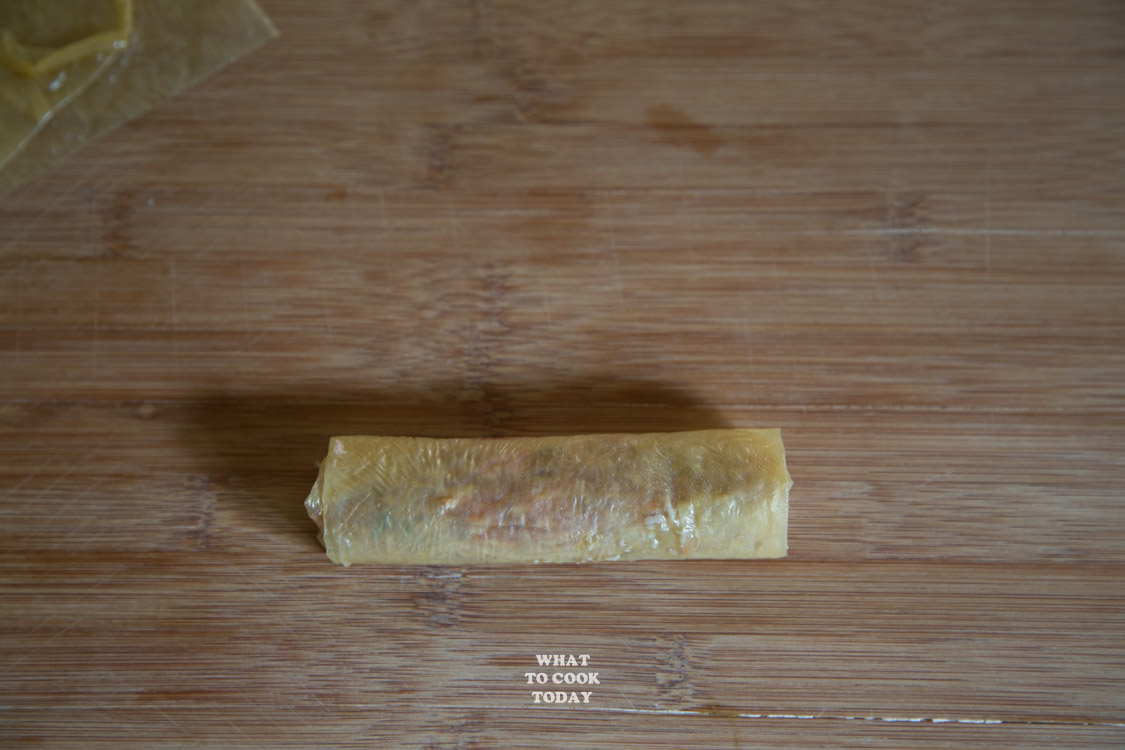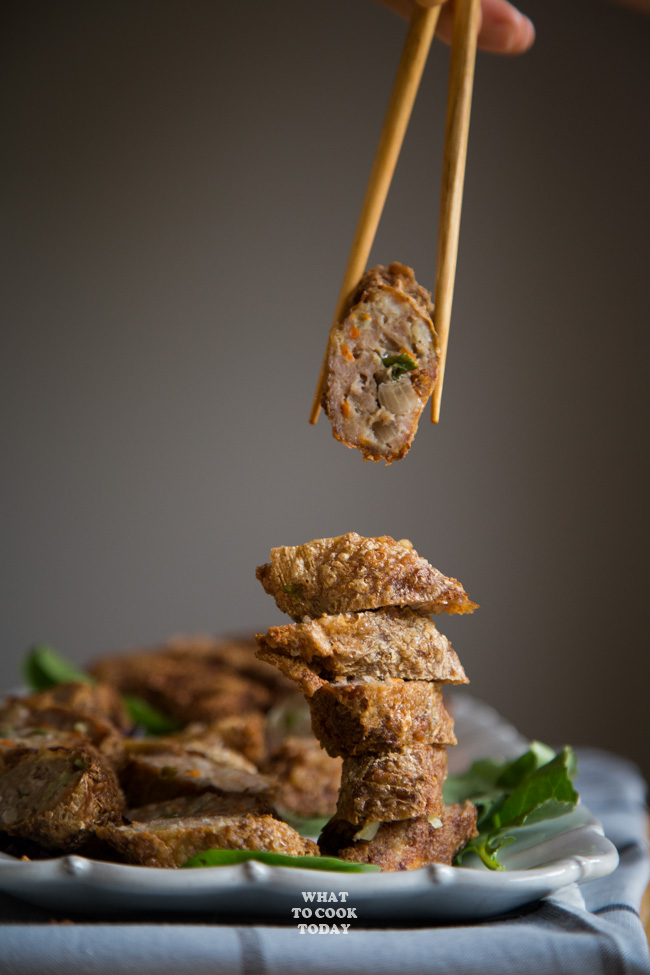This post may contain affiliate links. Please read our disclosure policy.
Learn how to make this popular Hokkien/Hakka ngoh hiang using ground meat seasoned with five-spice powder along with veggies are wrapped in dried bean curd sheets and wrapped into a sausage shape and then steamed and deep-fried or air-fried.

How To Make Ngoh Hiang (Lor Bak / Fried Meat Rolls)
This ngoh hiang recipe is truly one of the recipes that I’m glad my mom passed on to me. It is my mom’s classic meat rolls that I look forward to eating every Chinese New Year or any special occasion.
WHAT IS NGOH HIANG?
Ngoh hiang ( 五香) is a popular fried meat roll that is originated in Eastern China. I learned about the term ngoh hiang in Singapore. In Medan, we call it bak kien. Ngoh hiang is made with ground meat seasoned with five-spice powder, sometimes shrimp/fish paste is added, shredded jicama, shredded carrots, or other veggies, salted egg yolks and then wrapped in dried bean curd sheets into a sausage-like shape and then steamed and deep-fried.
WHY NGOH HIANG IS SO WELL-LOVED BY MANY
Ngoh hiang is a little elaborate to make but I can tell you it’s so worth it! The soft ground meat filling packed with amazing savory, slightly sweet, and umami flavor (salted egg yolks!!!) are what makes it so darn good. My husband and kids love ngoh hiang even before I deep-fry or air fry them. They love the steamed version too.

HOW TO WRAP NGOH HIANG
1. Cut the dried beancurd sheets into about 15 x 15 cm (smaller or bigger is up to you what size you want) or big enough to wrap the filling

2. Spread the filling on the lower half of the wrapper

3. If you have your own way of wrapping, please go ahead. There’s no right or wrong here. Fold both sides

4. Fold the bottom over and roll all the way up

5. Seal with a bit of egg white


Ngoh hiang after wrapped with dried bean curd sheets
NGOH HIANG CAN BE PREPARED AHEAD AND FREEZE
Yes! I love to make a whole bunch of them and then freeze. Here’s how to do it:
1. Prepare according to the recipe below up to the wrapping part
2. Steam over medium heat for 10-15 minutes or until cooked through

2. Place them on a large baking sheet individually not touching each other and freeze for about 1 hour
3. After 1 hour, you can move them to a freezer-friendly bag(s) and they won’t stick to each other
4. When ready to serve, just thaw them in the refrigerator and then fry until golden brown, or you can fry them frozen. It may take few minutes extra to cook through

WHAT TO SERVE WITH NGOH HIANG
Ngoh hiang is usually served as part of a multi-course Chinese meal at our house and I believe many Chinese families do the same, but it can be served as an appetizer or snack (yeah…Asian people snack on meat rolls LOL!).
Did you make this ngoh hiang recipe?
I love it when you guys snap a photo and tag to show me what you’ve made 🙂 Simply tag me @WhatToCookToday #WhatToCookToday on Instagram and I’ll be sure to stop by and take a peek for real!

The recipe was first published in 2012 and has been improved by adapting the recipe from here and to include a video.
How To Make Ngoh Hiang (Lor Bak / Fried Meat Rolls)
Ingredients
- 50 gr dried beancurd sheets unsalted version
For filling:
- 65 gr crackers see notes
- 500 gr ground pork about 80% lean
- 300 gr shrimp peeled, deveined, and finely chopped
- 200 gr water chestnuts finely chopped
- 200 gr shallots minced
- 1 small carrot grated
- 2 stalks green onion finely chopped
- 3 salted duck egg yolks steamed and mashed
- 1 large egg about 55-58 grams with a shell
- 1 Tbsp corn starch
For wrapping:
- 1 egg white about 30 gr, lightly beaten
Seasonings:
- 2 Tbsp Chinese five-spice powder
- 1 Tbsp sugar
- 1 tsp salt or more to taste
- 1 Tbsp fish sauce optional, but adds a nice flavor
- ¼ tsp ground white pepper
For frying:
- Oil enough for deep frying
Instructions
Preparing the filling (can be prepared the day before):
- Put all ingredients for the filling and add seasonings. Combine into a meat paste consistency
Taste the filling: (optional)
- We can't taste the raw filling here. You can microwave a tiny amount to have a taste or boil a tiny portion for you to taste. Adjust seasoning to your taste
How to wrap bak kien /ngoh hiang:
- Bring the water in a steamer to a boil and then lower the heat to let it simmer while you are going to wrap the meat rolls
- You should get the unsalted beancurd sheet, which is suitable for making ngoh hiang without being so salty. Cut the dried beancurd sheets into about 15 x 15 cm (smaller or bigger is up to you what size you want) or big enough to wrap the filling
- Spread the filling on the lower half of the wrapper. If you have your own way of wrapping, please go ahead. There's no right or wrong here. Fold both sides. Fold the bottom over and roll all the way up. Seal with a bit of egg white. This is necessary if you deep fry the roll so they won't open up during frying. For air frying, you don't need to seal. Repeat with the rest of the filling and bean curd sheets
Steaming (can be prepared ahead):
- Once you have all the meat rolls ready for steaming, Lightly oil the steaming dish. Place them on a steaming dish, seam sides down and not touching each other so they won't stick after steaming. Steam for 10 minutes on medium heat or until the meat inside is cooked through. Let them cool completely on a cooling rack before deep-frying. It is important to let them cool down before deep frying or air frying. You can prepare ahead up to this point
Deep-frying:
- Preheat about 2 inches of oil. When you dip a skewer or chopstick in the oil, it bubbles around it, the oil is ready
- Gently and carefully place the meat rolls into the oil and deep-fry until golden brown, about 2 minutes or so until golden brown. Use tongs to remove from the oil and place on a paper towel to let the towel absorbs some of the excess oil
- Let it cool down or 2 minutes or so before slicing with a very sharp knife. You can slice each roll into 3-4 pieces at an angle for presentation
Air frying:
- Brush the steamed ngoh hiang with a bit of oil. Place on the air fryer basket and air fry at 350 F (180 C) for 10-15 minutes. The time is just for a reference. Check in between cooking and flip them over as needed and cook until crispy and golden brown
RECOMMEDED TOOLS
Marv's Recipe Notes
*Nutrition facts are just estimates and calculated using online tools*



8 comments
“Taste the filling: (optional)
We can’t taste the raw filling here. You can microwave a tiny amount to have a taste or boil a tiny portion for you to taste. Adjust seasoning to your taste.”
Boiling would dilute the taste though microwaving could possibly work to a certain extend.
For me, with a strong stomach for copious amounts of raw food,, I would taste it raw.
For others not so naturally fortified, I can suggest dipping a finger into the filling, suck on it and then spit it out. You’ll get the real favor and the teeny weeny amount on the tongue likely won’t do any harm.
About the pinkish sauce, there’s no chilli in it al all. It’s a sweet sauce. No ketchup too.
It’s basically starch and sugar with stirred beaten egg white while the liquid is being boiled.
The pink is just coloring, probably from the marinate leftover from the making of the accompanying “side dish” sausage.
I’ve been making ngoh hiang at home for family and friends for decades and the salted egg yolk really enhance the rolls. I wouldn’t do without it, no way.
My old clan auntie from my ancestral village schooled me in this, and her ngoh hiang is out of this world; the taste contributed in great part by her use of strips of deskinned belly pork instead of minced pork. Makes a galaxy of a difference. Very tedious work but totally worth it.
I know of no one else who did it this good. Sadly, I only gained less than half of what she tried to impart to me as she was no longer around when I reached my early teens..
Henry from Singapore
Ancestral village is Ximei (formerly known as Chi’wei) in Nan’an county, Fujian province.
Hi Henry, thank you for sharing your tips and knowledge! I agree that salted egg yolks make ngoh hiang so much better for sure! I will have to try with pork belly next time.
Thanks for your recipe. What’s the crackers for? Is it substitute for water chestnut? What the texture of the crackers when you eat this? Thanks
Hello, the crackers are like breadcrumbs to bind the meat, it’s not a substitute for water chestnut. The crackers do not contribute to the texture of the meat rolls.
Hi, do you know how to make the hei Pia? The white prawn cracker that melts in your mouth that’s usually sold at the Ngor Hiang store? Also, do you know what the pink sauce is? I would be absolutely grateful if you’ll be able to teach me how to make them. I just moved to the US. And sorely missing my Singapore food.
And I just want to say thank you. I stumbled upon your website while looking for Kueh bangkit recipe. Your recipe helped me make CNY a little happier. And I’ve been turning to your site for my Singapore food fix. Please keep up the good work.
Hi Irina, ah..yes, the wu xiang xia bing. I haven’t tried to make that yet. The pink sauce seems like a combo of chili sauce and some ketchup, I’m not 100% certain. I will have to experiment on the hei pia and see. I’ll let you know for sure if I get good result LOL!
Dear Marvellina,
Do you think the recipe will still work without the salted duck egg? Or could I substitute them with anything else? Thank you.
Best,
Steffie
Hi Steffie, the recipe will still work without the salted duck eggs. It’s more for a taste and you don’t need to substitute with anything else. Just adjust the seasonings (may need to add a bit more salt to your taste). I hope this helps.